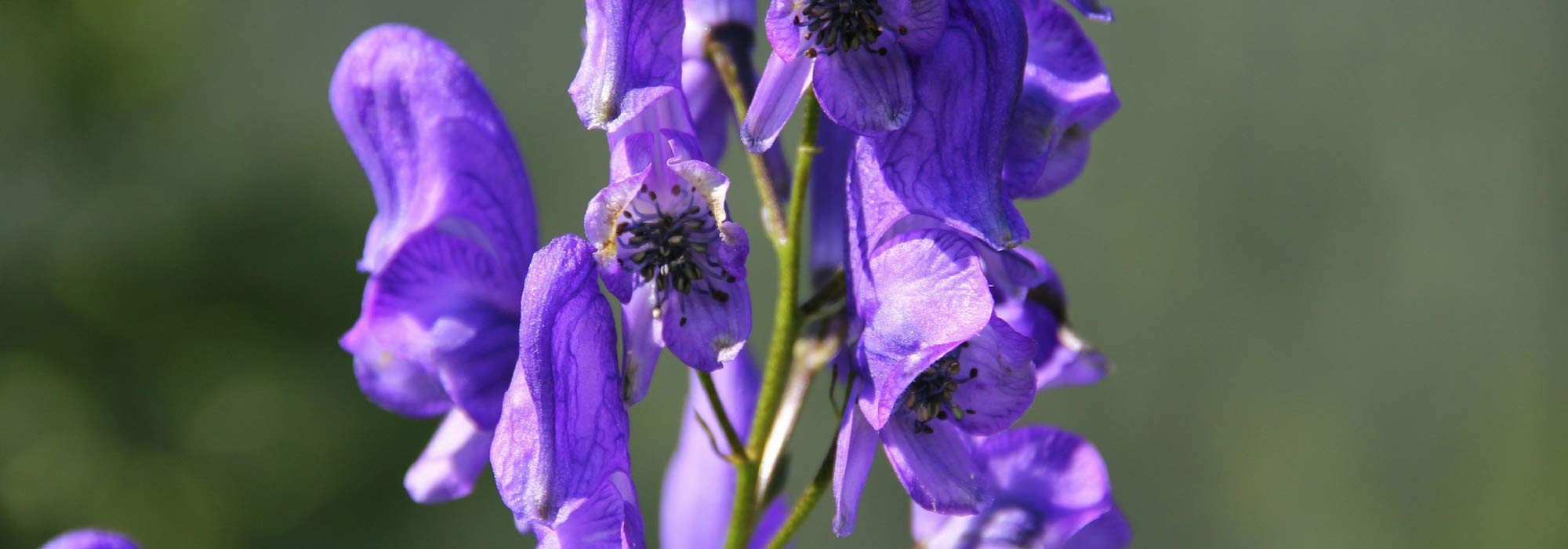
Aconitum, monk's hood: planting, care, division
Contents
Aconite in a nutshell
- Aconite or Aconitum napellus is a hardy perennial plant for partial shade, reliable and floriferous
- Its flowering, similar to that of delphiniums, spreads from June to October
- It bears one of the most beautiful blues in the garden
- It is architectural, with floral stems reaching up to 1.5 m in height
- It is hardy and easy to grow in borders, mixed-border
A word from our expert
Aconitum napellus or monk’s hood is a perennial plant with generous and long-lasting flowering. Aconitum, often associated with the word poison, suffers from a bad reputation due to its legendary toxicity, which has earned it the nickname “wolf’s bane” (Aconitum vulparia).
Aconitum, widely used today in homeopathy (notably Aconitum napellus or Aconitum napel), is still too unjustly overlooked in our gardens.
Majestic and delicate, its long floral spikes, sometimes reaching nearly 1.5m, stand tall above a beautifully dissected foliage, featuring spikes of flowers most often blue (Aconitum carmichaelii), white or yellow, and bloom from June to October depending on the variety.
Behind the apparent fragility of the flowers lies a very robust and hardy plant (-15°C). This beautiful tall perennial is easy to grow in all climates and thrives in cool, rich soil, preferably in partial shade.
Aconitum is valuable for introducing vertical accents and focal points in the back of borders or along edges. It easily combines with other reliable and floriferous perennials in opulent summer scenes. When cut, its inflorescences make very lovely bouquets with a rustic charm.
Its ample foliage and generous flower spikes will bring a striking and colourful touch to the garden. Discover our beautiful collection of Aconitum, from the most essential to the rarest!
Description and botany
Botanical data
- Latin name Aconitum
- Family Ranunculaceae
- Common name monk's hood, wolf's bane, helmet flower
- Flowering May to October
- Height 0.60 to 1.50 m
- Exposure Sun, partial shade
- Soil type Fertile
- Hardiness -15°C
The genus Aconitum contains over 100 species or hybrid cultivars of perennials and biennials growing wild in the humid montane meadows of Europe and Asia. Aconitum or “monkshood”, sometimes incorrectly referred to as “wolf’s bane”, is a beautiful herbaceous perennial belonging to the family Ranunculaceae, like its cousin Delphinium.
Among the most common in our gardens are:
Aconitum napellus, also known as monkshood, with large indigo blue spikes, Aconitum carmichaelii, as well as hybrids like Aconitum x cammarum. Some species such as Aconitum volubile are climbing and can reach heights of 2 m.
Aconitum is a perennial plant that often takes one to three years to truly establish, but once well settled, it develops from a fleshy tuberous stump from which emerges in spring a superb deciduous and erect tuft formed of stems that are sometimes quite woody, slightly hairy, and rigid, more or less voluble.
Its habit is somewhat lanky. It stands 50 cm to 1.50 m tall when in flower, with a spread of 30 to 50 cm at maturity, depending on the species.
Aconitum is highly toxic in all its parts, and one of the most deadly plants in our flora by ingestion of roots, but it is extremely rare to be poisoned unless one ingests its roots, which even animals avoid!
Very floriferous, this perennial is always noticed in a garden. Its upright stems bear above the foliage, from May to October, depending on the species, large airy spikes adorned with numerous flowers. These curious flowers, with hoods of sepals 3 to 5 cm long, are grouped in clusters or very branched terminal panicles 30 to 60 cm long, at the ends of the branches.
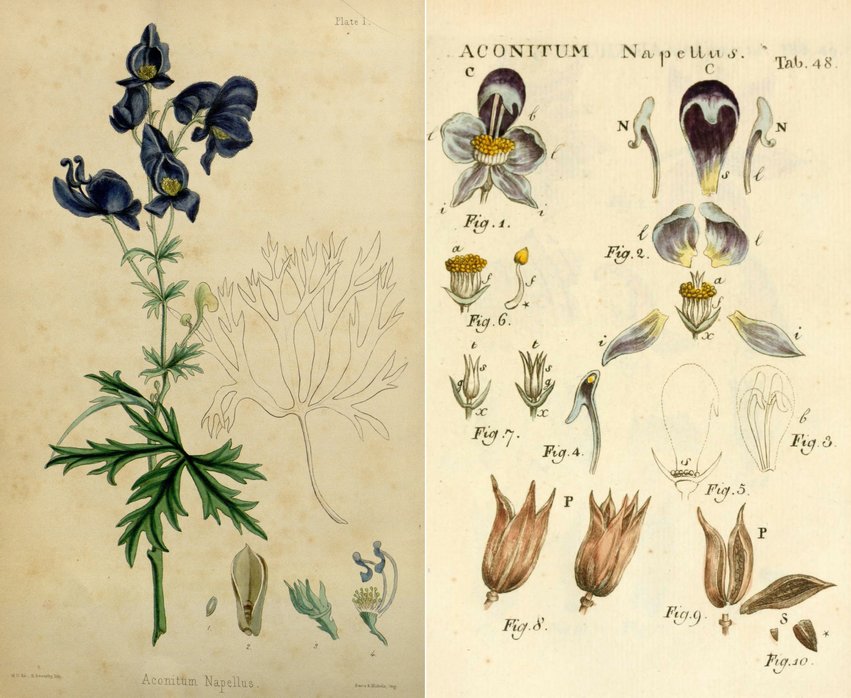
The botanical plates of Aconitum napellus detail the plant, its flower, and its seed capsule.
Composed of 5 satin sepals, slightly raised at the edges, and numerous contrasting stamens, the flowers take on an original shape reminiscent of an ancient helmet, hence the nickname “Jupiter’s helmet”.
From deep violet blue to steel blue veined with ultramarine, through lavender blue and indigo blue, Aconitum ranks among the most beautiful blues in the garden, alongside gentians and delphiniums.
The horticultural cultivar Aconitum x cammarum features inflorescences whose palette ranges from white to purple, including bicolour varieties like Aconite ‘Bicolor’ with violet blue and white flowers.
While the flower spikes mainly bear blue flowers, some varieties are white (Aconitum napellus ‘Schneewittchen’), pink (‘Carneum’), pale yellow (Aconitum anthora), cream (Aconitum septentrionale ‘Ivorine’), and sometimes violet.
These are also very beautiful bouquet flowers that will last a good week in a vase. This abundant and melliferous flowering attracts bees and pollinating insects.
With dark green leaves that have a glossy surface and a pubescent underside, the foliage of Aconitum is among the most beautiful in perennial plants. The upright stems bear large deciduous, veined leaves, 5 to 10 cm long. Round or ovate, deeply cut into 3 to 7 lobes, they somewhat resemble those of Delphinium.
Aconitum is not a difficult perennial to grow. Very hardy, it fears neither cold nor frost and is suitable for all regions. It grows in any deep, cool, well-fertile and well-drained soil, in a partially shaded position, in a location sheltered from strong winds.
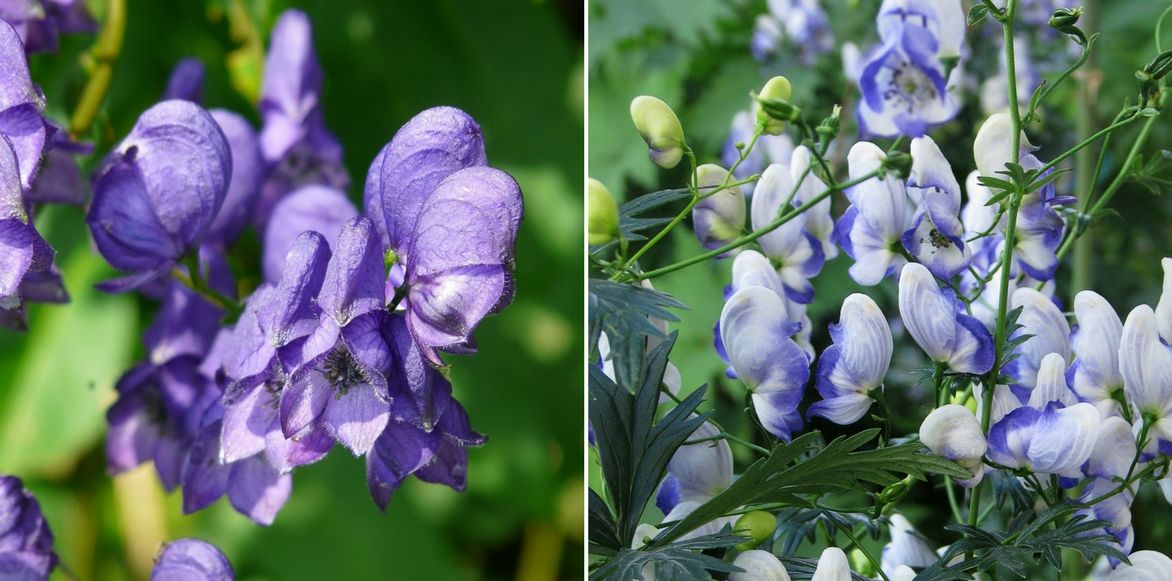
From left to right: Aconitum napellus – Aconitum cammarum ‘Bicolor’.
This beautiful perennial with a somewhat architectural habit is perfect for the back of a border or in a flower bed, alongside foxgloves, delphiniums, and actaeas, for lush summer scenes.
Main species and varieties
There are over a hundred species or hybrid cultivars of monkshood. The main selection criteria are the flower colour, ranging from indigo blue to lavender, pure white, cream yellow, or even old rose, and the height (from 0.50 m to 1.5 m tall), which offers great diversity. By combining different species of monkshood well, one can achieve flowering from spring to autumn!
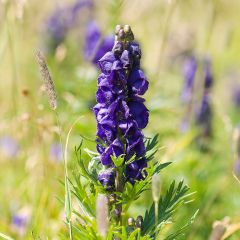
Aconitum napellus
- Flowering time August, September
- Height at maturity 1,20 m
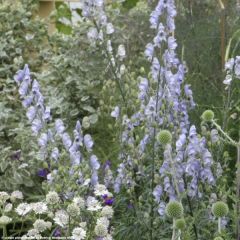
Aconitum Stainless Steel
- Flowering time July to September
- Height at maturity 90 cm
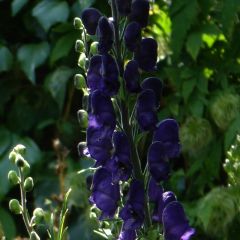
Aconitum henryi Sparks Variety
- Flowering time October, November
- Height at maturity 1,50 m
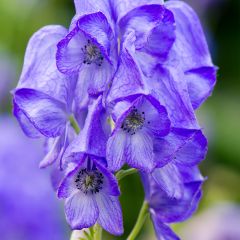
Aconitum carmichaelii Arendsii
- Flowering time October, November
- Height at maturity 1,20 m
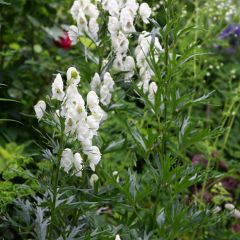
Aconitum napellus subsp. napellus Schneewittchen
- Flowering time August, September
- Height at maturity 1 m

Aconitum cammarum Bicolor
- Flowering time July to September
- Height at maturity 1,20 m
Discover other Aconitum
View all →Available in 0 sizes
Available in 1 sizes
Available in 1 sizes
Available in 1 sizes
Available in 3 sizes
Available in 1 sizes
Available in 1 sizes
Available in 1 sizes
Available in 1 sizes
Available in 1 sizes
Planting
Where to plant Aconitum?
Aconitum thrives in various locations across France, except perhaps in very windy regions, where the wind can sometimes flatten its stems, posing a threat to this tall perennial.
It retains, from its montane origins, excellent hardiness, tolerating temperatures around -20°C. However, it does not appreciate winter moisture. It prefers to be planted out of strong winds and in a well-exposed site, which encourages the plant to reach its full height.
It favours shaded situations, especially in the hottest regions, but it is a very accommodating plant that tolerates sun as long as the soil remains moist. It only fears drought and overly poor soils.
A meadow plant, it enjoys fertile soils, rich in humus, deep, cool, but not waterlogged. The soil must be very well-drained, yet constantly moist and never dry out in summer.
More forgiving than delphinium, it even grows in clay soil and is not afraid of slugs, making it a suitable alternative to larkspur in gardens with heavy, moist soil.
It integrates into all settings, whether in borders or mixed borders, planted among bushes or in light undergrowth. It adds depth and striking verticality to all compositions. It can also be placed against a wall.
Pot cultivation is not recommended for this plant, which prefers coolness and deep soil.
When to plant Aconitum?
Planting aconitum is preferably done in spring (from March to May) or in autumn (in October).
How to plant Aconitum?
Planting Aconitum is straightforward in well-prepared and enriched soil.
Plant in buckets in groups of 5 to 6 plants per m², spaced 30 to 50 cm apart depending on the varieties to allow the plant to develop well. For a beautiful effect in a border, it is best to plant in numbers.
- Dig a hole twice as wide as the root ball
- Add potting soil, compost, and turf at planting
- Plant without burying the stems too deeply, so that the top of the root ball is level with the soil surface
- Water generously until established and during dry weather.
- Mulch to aid establishment and keep the soil cool in summer
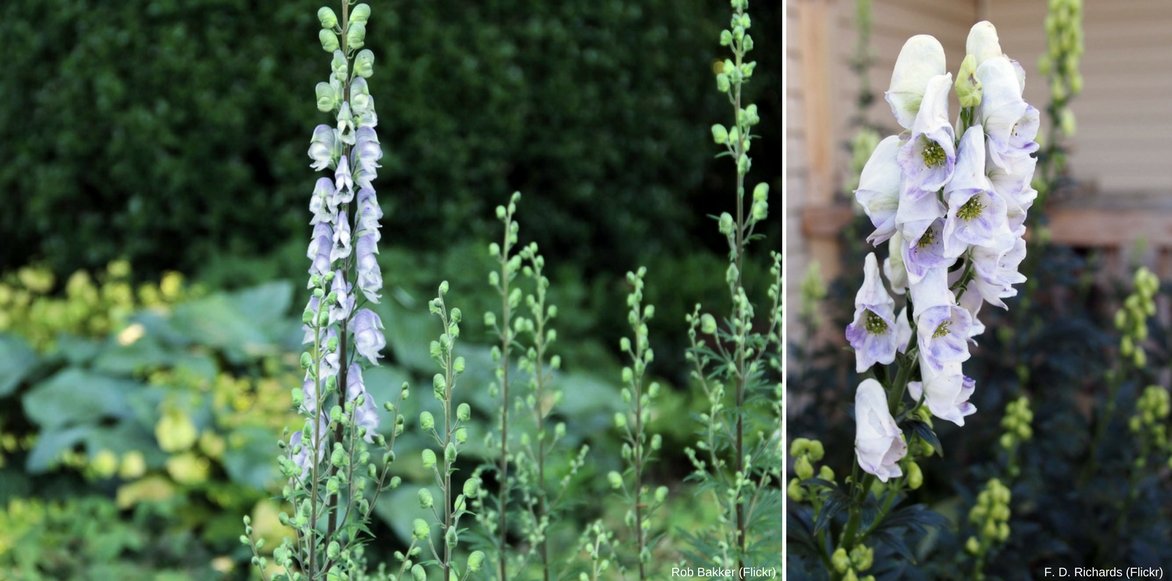
The floral spikes of the Aconitum ‘Stainless Steel’ offer delicate grey-blue hues.
Maintenance and care
Aconitum requires only a little care to flower generously again. This perennial plant needs coolness in summer and no stagnant moisture in winter.
Install a mulch to maintain some coolness and water regularly during dry weather, but without excess.
Remove faded flowers promptly after flowering to prolong the flowering period or leave them to seed for future sowing.
In spring, at the start of growth, cut back the faded flower stems to ground level to prevent water and moisture from entering the hollow stems during winter, which can cause the clumps to rot. Add a little compost in spring to maintain soil fertility and retain moisture.
Support the stems of tall varieties with sturdy canes in spring as soon as growth begins, to ensure the plants are anchored when the flower spikes emerge.
For old clumps, it is advisable to divide them to maintain beautiful blooms. To keep the plants vigorous, divide every 5 to 7 years in autumn or February, as soon as you notice that flowering is diminishing.
→ To learn more, read our tutorial: “How to prune Aconitum?“.
Diseases and potential pests
Aconitum is a hardy perennial that offers very good resistance to diseases as well as to parasitic threats.
Slugs are not fond of it, unlike delphiniums!
It only fears drought and excess water.
In cases of excessive moisture and overly heavy soil, it can be affected by white rot, a disease (from the verticilliums) responsible for root rot. This is why, as a preventive measure, it is essential to ensure it is planted in a location where water is unlikely to stagnate. Be careful not to bury its stems too deeply during planting to avoid this type of fungal disease, which thrives in waterlogged soils.
Good growing conditions often prevent these virulent attacks.
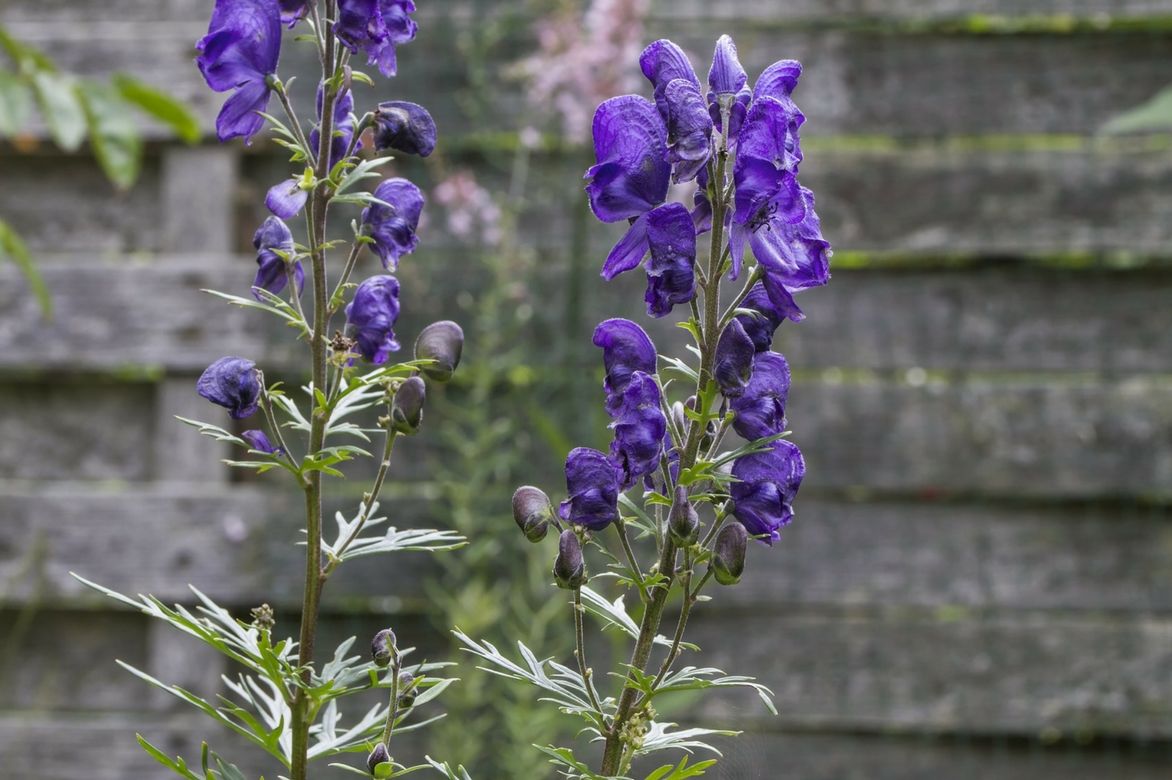
Propagation of aconites: sowing, division
Sowing is possible (after stratification, meaning a prior cold treatment) but the results are very unpredictable. Seeds are harvested in autumn, stored in the fridge during winter, and sown in spring, under a cold frame, if you haven’t cut all the flower stems; otherwise, buy them in packets. Nevertheless, your sowings will only flower the following year. There are less tedious methods!
You can multiply Aconite by dividing the tuberous clump, even though it does multiply spontaneously over time. Aconite plants lose vigour as they age: after 5 years, the clumps become less floriferous and sometimes weaker. Therefore, do not hesitate to divide the plants every 5 to 7 years, in autumn or very early spring, if you want to maintain their vigour.
Dividing an Aconite
- Dig up the plant with a spade
- Divide into several sections containing both roots and shoots
- Replant the largest tubercles immediately
- Water generously and then regularly to encourage recovery
Learn more in our tutorial How to propagate Aconite?
Associating Aconite in the garden
Aconite fits into all décors. Very easy to pair, it is even inspiring for creating a naturally styled garden, with plants that require little care and maintenance.
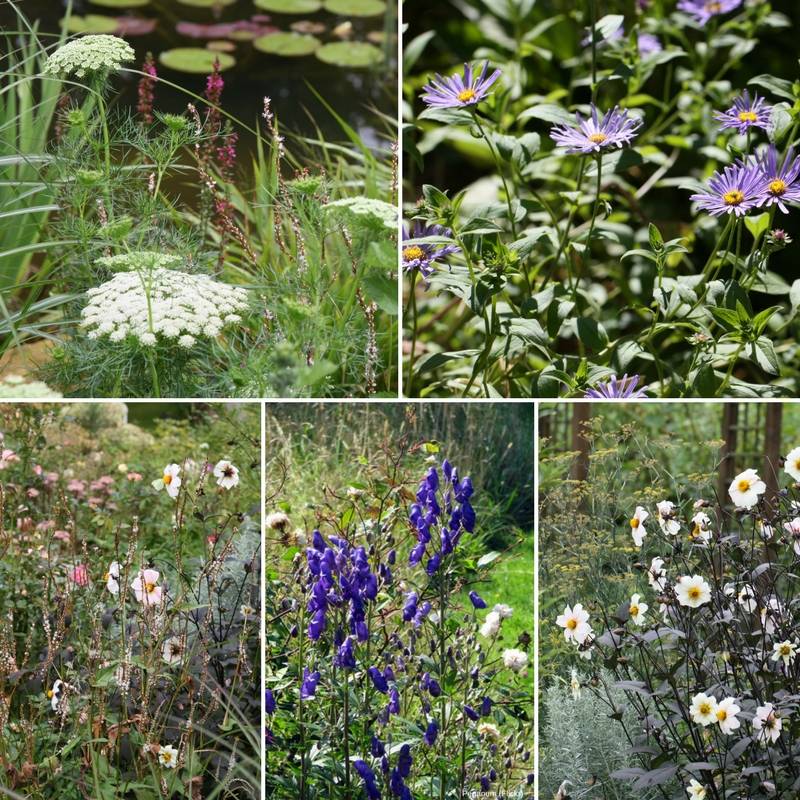
An example of a natural association: Amni visnaga ‘The Giant’ – Aster frikartii ‘Monch’ – Persicaria amplexicaulis ‘Alba’ – Aconitum carmichaelii ‘Arendsii’ – Foeniculum vulgare ‘Giant Bronze’ – Dahlia ‘Twining’s After Eight’
It forms beautiful bushes at the back of semi-shaded beds, and it is also stunning as a flower for borders. It can be very exuberant or more discreet. The vertical dimension it brings helps to structure the beds like natural scenes at the edge of woodlands.
A reliable choice for herbaceous borders and cottage gardens with a rustic feel or prairie-style gardens, it is appreciated for its majestic clusters of flowers, white, pink, yellow, but most often an incredible blue.
It accompanies the flowering of delphiniums and like them, it is a must-have for blue gardens.
Blues/golds, cream/sweet orange, Aconite is perfect for playing with contrasts, shades, and gradients, transforming a bed into a remarkable impressionist tableau. The deep violet-blue clusters of Aconitum napellus contrast beautifully with the pale yellow achilleas.
The Aconitum napellus ‘Schneewittchen’, a white variety, is a classic in white gardens where it will grow alongside a Echinacea ‘Green Jewel’ and digitalis ‘Snow Thimble’.
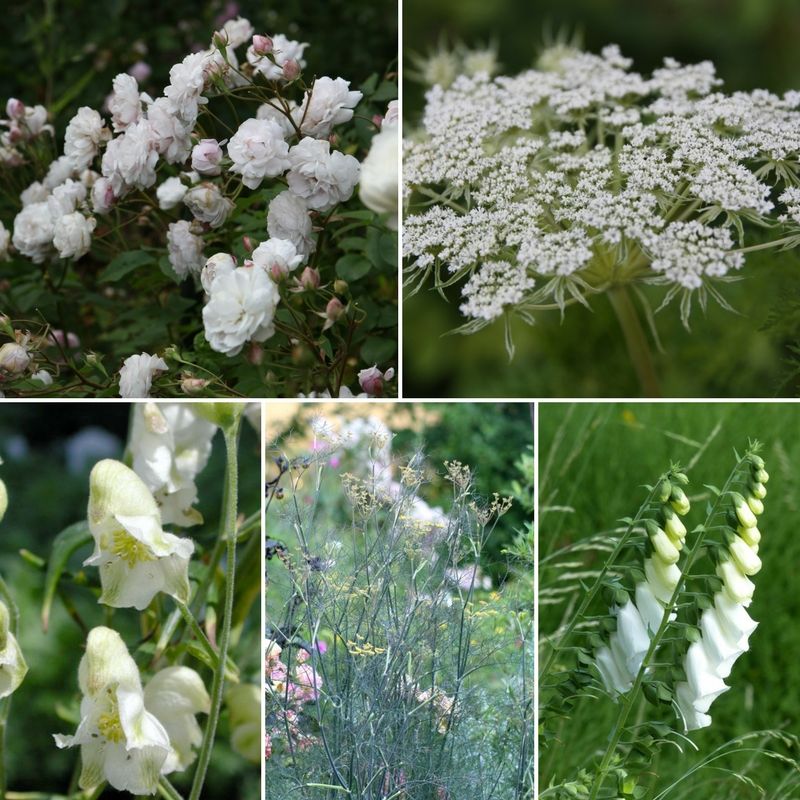
An example of a refined association: Rose ‘Blush Noisette’ trained as a bush – Selinum wallichianum – Aconitum napellus ‘Schneewittchen’ – Foeniculum vulgare ‘Giant Bronze’ – Digitalis purpurea ‘Snow Timble’.
At the back of the border, it will accompany large hardy geraniums, dahlias, or grasses such as miscanthus.
In summer, it associates in lush beds with astrances, rudbeckias, veronicas, phlox, and cosmos. Its spectacular foliage and summer flower spikes blend well with Oriental poppies.
The later varieties (Aconitum carmichaelii ‘Arendsii’, Aconitum ‘Spark’s Variety’) will pair beautifully with asters, Japanese anemones, and chrysanthemums, creating lovely autumn scenes.
They are also very beautiful in front of the autumn foliage of a Persian ironwood or sweetgums.
Also discover our article: Aconite: 7 ideas for pairing it in the garden
Useful resources
- The most beautiful collection of Aconite is with us!
- Subscribe!
- Contents































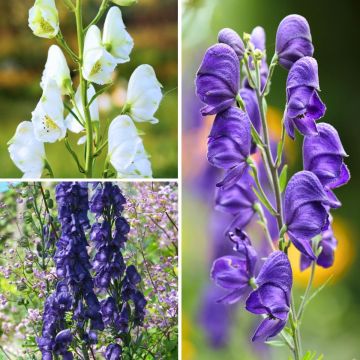
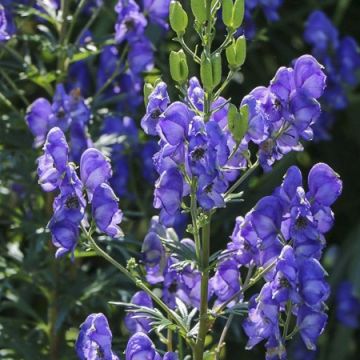
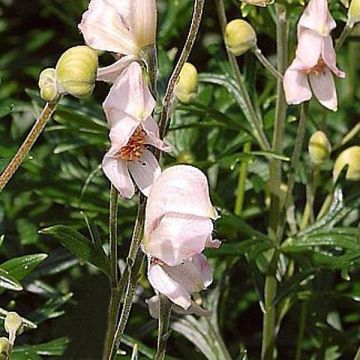
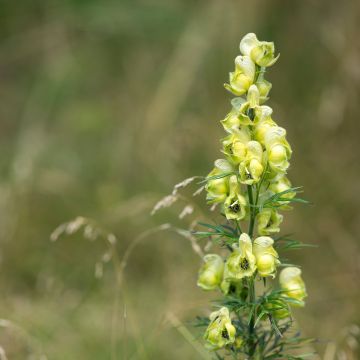


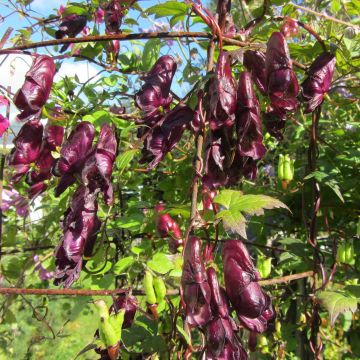

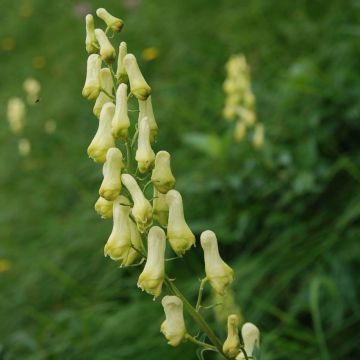
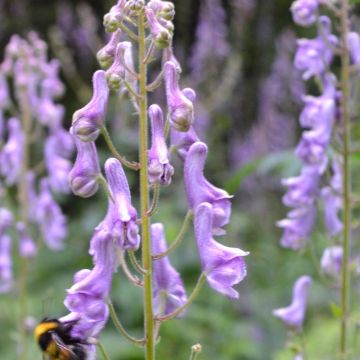
Comments